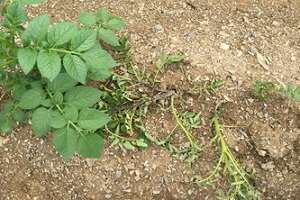In 2015 and 2016, an aggressive form of black leg/soft rot caused by the bacterial pathogen Dickeya dianthicola was confirmed in a potato seed lots being grown in numerous states in the mid-Atlantic and Northeast regions including Pennsylvania.

Based on our current knowledge, a set of grower best management practices have been prepared by Meg McGrath (Cornell) and Andy Wyenandt (Rutgers) with assistance from Steve Johnson (University of Maine), Kate Everts (University of Maryland), Beth Gugino (Penn State), and Nate Kleczewski (University of Delaware).
Symptoms of blackleg/soft rot caused by Dickeya infection are very similar to those caused by Pectobacterium spp. It can manifest itself as poor seed emergence as well as a water soaking and blackening of the stem pith and vascular system under wet conditions. The leaves then become yellow and curl upward. It can also cause a soft rot of potato tubers since the bacteria are able to degrade or feed on the pectate found in the cell walls causing them to break open and leak their cell contents. Dickeya is favored by high temperatures above 77°F and moist conditions.
Potato seed tubers harboring Dickeya dianthicola are currently the only confirmed source of this pathogen. It does not appear to be able to survive in soil (including crop debris) from one growing season to the next. Consequently, rotating with a non-susceptible crop is not a necessary component of the management program. The current best management practices listed below are encouraged to minimize potential losses from Dickeya.
Note: While Dickeya is an emerging pathogen and of greatest concern, bacteria in the genus Pectobacterium continue to be responsible for soft rot disease in eastern and mid-western states and are the most common soft rot pathogen in some areas.
1.Select certified seed with negligible potential to be contaminated with Dickeya. This is best determined by talking with the seed grower about past occurrence on the farm and what is being done to manage it. There are growers who have not had Dickeya develop from their seed.
- Select seed from farms where the pathogen has not been detected and seed marketed in previous years was not associated with Dickeya developing where the seed was planted. Check Certificates before purchase to determine if the seed was increased in previous years on a farm where Dickeya has been detected and so is at risk for being contaminated.
- Select seed from farms where zero tolerance is being implemented.
- Select seed with zero blackleg levels reported on the North American Seed Potato Health Certificates or the Winter Grow Out Test results for presence of Dickeya in ANY seed lot from ANY source. Seed lots with field readings of blackleg present should have reports that suspect plant samples were taken for testing and found to be Dickeya free. Check Certificates before purchase and require a copy be provided for your records.
- Select seed that tested negative for Dickeya. Note that not detecting a pathogen in a sample of seed does not mean the pathogen is not present in the seedlot.
- Ask for ‘references’ to contact: potato growers who purchased their seed in 2016.
- Avoid seed lots that tested positive for Dickeya in previous years.
- Avoid seed if its Certificate is unavailable. All certified seed has a Certificate.
- Avoid seed from fields where symptoms of Dickeya were observed, even if affected plants were rogued out.
2.Request from supplier (directly from grower or broker) PCR testing for Dickeya dianthicola using an independent laboratory.
3.It is recommended that each truckload brought to a farm operation be sampled and re-tested for Dickeya once delivered. All results should be reported to your State Department of Agriculture or Potato Growers Association.
4.All equipment during seed piece cutting should be disinfested on a regular basis (at least daily), and also between lot numbers.
5.While it is recommended to rotate where potatoes are grown to manage most pathogens that can survive in unharvested tubers, this practice is not considered important for Dickeya because this pathogen does not readily spread in fields (thus a few tubers with Dickeya will not result in significant disease outbreak as can occur with late blight) and infected tubers are likely to rot while in soil.
6.Inspect fields for symptoms regularly, starting when skips and affected plants are readily visible. Examine the crop for unevenness (erratic growth) and plants that are unthrifty. Dickeya can be present in a plant affecting growth but not causing its typical blackleg symptom. Growers are encouraged to submit suspect samples for testing promptly to their local extension office in order to confirm Dickeya is the cause and to contribute to knowledge about Dickeya occurrence, and also to share their observations of Dickeya with the seed producer.
7.Avoid excess irrigation that results in standing water as Dickeya can move in this water. Note that surface irrigation water is not considered to be a possible source of Dickeya.
8.Do not apply copper or other fungicide for Dickeya. They are ineffective being unable to reach the pathogen, which is inside stems.
9.All growers are requested to share information about Dickeya occurrence and absence in their production fields. This information is needed to improve understanding about this disease. Include variety, lot number (North American Seed Certificate), field location, and testing results.
10.Dickeya has not been observed to continue developing in storage, which is as expected considering high temperatures are favorable, thus there are no management steps to implement after harvest for table-stock potatoes. However, it is prudent to make sure storages and pile temperatures remain cool, also reduce condensation and encourage airflow and exchange.
Source: psu.edu